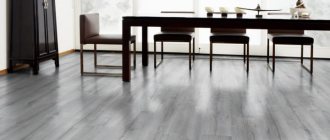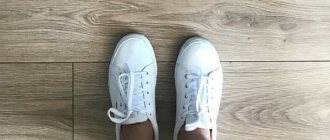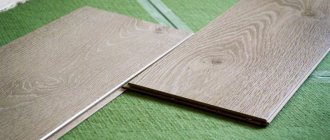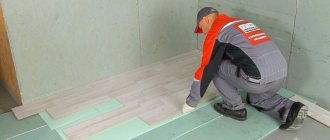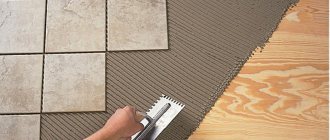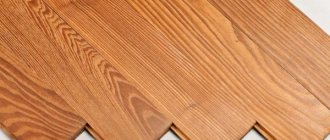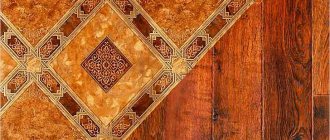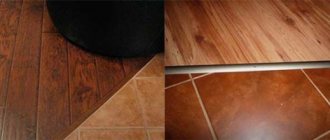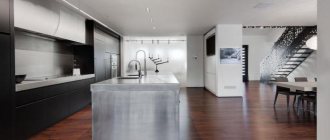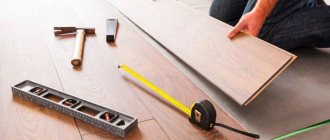The popularity of laminate, which it acquired almost from the first days of its appearance on store shelves, can be explained by quite ordinary reasons - it is easy to install and maintain, has an excellent appearance, is capable of partial repairs, and you can do the laying of laminate yourself, without turning to outside specialists.
In addition, the surface of the laminate is warm and pleasant to the senses, which is important, especially in the off-season.
But the most important advantage of the material is its ability to be laid on old coatings that there is no desire or need to dismantle.
In some cases this can be very convenient, especially if dismantling the old material will lower the floor level too much.
Some types of old coatings serve as a high-quality basis for the laminate, increasing its performance.
Let's take a closer look at the question.
Is it possible to lay laminate flooring on linoleum?
This question is often asked on various online platforms. Doubts about this are a consequence of the unpreparedness of people who have little understanding of the technology of laying laminate flooring. It states that the base must be dry, clean and level.
If linoleum meets these requirements, then installation can be carried out without fear . At the same time, the evenness of the surface cannot be checked by eye, since the linoleum sheet always looks quite smooth and flat. But in reality there may be significant differences that are unacceptable when installing laminate flooring.
At the same time, the linoleum layer can be considered as a kind of substrate that provides an elastic gasket between the subfloor and the new coating. It helps to correct small potholes or bulges in the floor, promotes a tighter fit of the laminate, which eliminates noise when walking .
Sound insulation is an important aspect of laminate flooring; no measures in this regard will be unnecessary.
IMPORTANT!
Old linoleum must be solid, without cuts or holes. This will help ensure that capillary moisture is cut off from the subfloor.
Preparing the floor surface
Preparing the floor before laying the laminate is a must if you want the end result to please you and the laminate to last a long time and not begin to creak, swell and jump out of the grooves after a month of use.
The list of preparatory work depends on the type of floor.
If the floor is concrete, all cracks and irregularities will need to be repaired. If the condition of the concrete floor is very unsightly, then it is better to fill the screed.
The photo shows a cement mortar screed. It should only be used in cases where the condition of the concrete floor is clearly unsatisfactory. In other cases, a self-leveling self-leveling floor will be sufficient.
After the floor has dried, all significant roughness should be removed from its surface using a spatula, then sweep and vacuum the floor.
Important!
Keep in mind that concrete floors take quite a long time to dry. This may take several days. You can check whether the floor is completely dry by leaving a plastic bucket on the floor in the evening. If, when you lift the bucket in the morning, you see a dark circle on the floor, and even more so drops of condensation, then the floor is not completely dry yet.
Before performing the next operation, it is highly advisable to prime the concrete floor. This will improve the surface properties of the solution. In addition, the floor will not generate dust, which is typical for concrete floors. Concrete primers are sold at hardware stores.
The next step should be to waterproof the floor. This is necessary so that the laminate does not draw moisture from the concrete floor, which happens when there are temperature changes.
For waterproofing, ordinary polyethylene film is used, laid with overlapping joints of about 10 cm and fastened together along the seam using masking tape.
If you have a wooden floor, then the above steps will not be necessary, but surface preparation is still needed, just different.
To do this, you will need to secure the creaking boards with self-tapping screws, fill the cracks in them and, if possible, level the floor surface. If this is difficult to do, then it would be better to lay sheets of fiberboard or plywood 5-6 mm thick on top, securing them with self-tapping screws.
Which class of laminate is suitable?
Laminate classes determine the degree of its resistance to abrasion. They have nothing to do with the quality of the base, determining only the resistance of the material to external influences . Therefore, when choosing a laminate, you should be guided by its operating conditions.
If you plan to install it in a bedroom, where there are not many people and movements are minimal, you can get by with 31 classes. For busier rooms, resistance class 32 is suitable, the most common of all. 33 or 34 classes allow you to use the coating in crowded places, shops, discos or airports, but the cost of these materials is the highest.
NOTE!
The higher the class of the laminate, the higher its resistance to moisture usually is, although this is not directly related. When choosing a material, the issue of moisture resistance should be raised separately so as not to get an unpleasant surprise.
How laminate conducts heat
Many users of our portal note that the thermal conductivity of laminate flooring, which is lower than that of tiles, leads to increased consumption of gas or electricity: if the floor coverings in the house are combined, then the same temperature in the rooms can be achieved by opening the water-heated floor taps under the tiles to half, and under laminate - at full capacity.
BobahinaFORUMHOUSE user
Laminate will always be “colder”: thermal conductivity from the TP into the room through it will be noticeably worse.
But the difference is not so critical, it doesn’t hurt your wallet, and in practice laminate is the most popular coating for water-heated floors. And for electric floors in recent years too.
In order for a room with such a coating to warm up better, it makes sense to work on the direction of the heat flow - make a foam concrete screed, and then the heating elements of the heating element will not heat the stove, the heat will go up.
Checking the evenness of the floor
The condition of the floor is the main point in the laminate installation technique. Allowable differences are within 2 mm per meter of floor length. At the same time, it is very difficult to determine the condition of the surface; at first glance, it often seems that the floor is ideal.
Verification methods:
- Use a flat, straight strip, ruler or meter-long building level. By applying them to the floor in different areas, you can obtain information about the presence of differences or folds.
- The hydraulic level gives a completely accurate idea of the rise or fall of the floor topography relative to one point.
- The oldest and most effective method is stretched cords, which clearly show the condition of the floor, the presence of folds or bulges and other parameters of the old coating.
There are also methods for checking the floor with a laser level that give an accurate and high-quality result, but in the absence of this device it is quite possible to get by with these methods.
Performance properties of laminate
Laminate is a very advantageous floor covering material for several reasons:
- laminate is perhaps the most fashionable of the affordable floor covering materials;
- it looks great, imitating the appearance of valuable wood species;
- this material has a fairly high wear resistance, so it will last a long time;
- it is easy and quick to install if you know how to lay laminate correctly.
Due to its good performance properties, as well as a large selection of colors, laminate has become widespread. It’s not in vain that you are interested in this topic, right?
Despite the fact that this article is called “How to lay laminate flooring correctly,” I decided to first give you information about the types of laminate flooring and the criteria for choosing it correctly. After all, this is also very important. If you purchase low-quality laminate, then there is little point in laying it, because it won’t last long.
Preparation for installation
Preparatory work begins with removing all foreign objects and dismantling the baseboards. The surface of linoleum is thoroughly cleaned of dust and dirt . It is checked for the presence of moisture under the coating, for which a plastic film is laid on the surface and pressed tightly with the edges to the floor.
After a couple of days, the film is checked and if no droplets of water are found on the side facing the floor, then the condition of the base is good and the humidity is normal.
Cut or torn areas of linoleum are extremely undesirable, but if necessary they can be partially restored. To do this, the damaged areas are glued to the subfloor. The edges of the cut fabric are bent to the sides, a layer of glue is applied to the floor, the edges are laid back on the surface and pressed while the adhesive layer dries.
If you have replacement material, you can fill the holes in this way by cutting out the problem area from the old coating and gluing a fragment that exactly matches the shape into the resulting hole..
If the old covering has folds or waves, you can carefully trim it around the perimeter and stretch it across the area of the room, smoothing out the folds and achieving a flat surface.
Why do you need a backing for laminate flooring?
Laminate is a material of artificial origin, but it is mainly made from natural raw materials. The basis of the board is fibreboard. Like ordinary wood, fiberboard and MDF do not tolerate being in a humid environment quite well.
In addition, the slab is rigid, so if you lay it on an uneven base, it may break over time at the bend.
Not a single one, even the highest quality laminate, will last long if it is laid directly on a concrete slab. This is due to the fact that when assembling the lamellas, locking connections are used, which create the impression of a solid surface.
And if the load is distributed unevenly, then the strength of the locking joints is lost, cracks form on the floor, and a creaking sound is heard when walking.
Thus, a special damper layer is required, which not only softens the load, but also redistributes it over the entire surface. As a result, the locking connections remain strong for a long time.
Selecting a substrate
Any of the popular materials can be used as a substrate.:
- Rolled technical stopper.
- Izolon.
- Expanded polystyrene.
- Slab coniferous substrate.
The quality and performance characteristics of these materials are quite satisfactory for most users. The hottest debates are regarding isolon (foamed polyethylene) and technical cork.
At the same time, the arguments of both sides are quite convincing, but they relate to specific situations and do not consider the possibility of other conditions. Therefore, the choice of material is easiest to make based on considerations of economy and the thickness of the substrate, so as not to cause too much rise in the floor level .
What is a substrate
The substrate is a coating for the manufacture of which both natural and synthetic materials are used. Thanks to the use of such products, the laminate adheres much more tightly to the rough concrete or wooden base. In addition, the coating helps to even out differences in altitude and acts as a heat insulator. Today there is a large selection of such materials in a wide price range, including both expensive and cheap products. Let's consider the possibility of laying laminate flooring without it.
Substrates
Is installation possible without a backing?
The underlay is a mandatory element when installing laminate flooring. There are known cases of laying material without it, which were without consequences, but one should not hope for such a favorable outcome . The absence of a backing will cause a drum effect; the covering fabric will begin to slap the base when walking, which greatly gets on the nerves of both the apartment owners themselves and their neighbors.
Therefore, laying without a backing is considered extremely undesirable. At the same time, if the coating is linoleum on a thick felt base, then you can do without a backing, especially if the area of the room is small and does not have height differences.
Is it possible to install panels without using a backing?
The question: is it possible to lay laminate flooring without using a backing? Many people are interested in it. It is impossible to answer this question unequivocally; laminated panels can be laid even on a bare concrete base, but there are a large number of disadvantages:
- Laying laminate flooring without a backing causes unpleasant sounds when walking on the floor. This occurs due to the contact of the panels with the cement screed.
- Laminate is not a thermal insulator, so the floors will be cold in the winter.
- The absence of a substrate will also affect the soundproofing properties of the coating. Any conversations and steps will be heard by neighbors.
- The substrate significantly increases the service life of the laminate by preventing abrasion.
- The absence of a backing can lead to cracks in the panels and gaps between them due to uneven floors. A common cause of such defects is a breakdown of the locking mechanism.
As a result, frequent repairs and replacement of a cracked panel despite the fact that the service life has not yet ended.
As you can see, this solution has many disadvantages, and in order to avoid troubles in the future, you need to do everything according to the rules.
Required Tools
The list of tools used for installing laminate flooring is quite wide.
It includes:
- Ruler, square, tape measure.
- A hammer with a regular or rubber striker.
- A hacksaw with a fine tooth, some prefer a hacksaw for metal.
- Electric circular saw or jigsaw.
- Electric drill.
- Shoemaker's or stationery knife.
These tools are quite widespread and are available to almost every home craftsman.
Specialized devices are also needed, used only when installing laminate flooring.:
- Tamping block. Unlike the usual one, it has a special profile that does not destroy the locking part of the panels.
- Installation wedges. You can cut them yourself, but purchased special wedges have the required thickness, expansion angle and special notches that prevent the wedge from being squeezed out when the load is applied.
- Bracket for laminate flooring. It simplifies the padding of panels located near the wall, for example, in the last row.
- Clamps for laminate. They allow you to carefully and tightly press the panels against each other, eliminating the formation of cracks or gaps.
- Knife for laminate. It looks like a photo cutter, only greatly enlarged. Allows you to cut panels in a perpendicular direction. clean and precise.
IMPORTANT!
You can purchase these tools separately, or buy a set for laying laminate flooring, which includes all the most necessary accessories for installation.
Purpose
The backing for the laminate is a material that is characterized by low density. The main purpose of this substance is to smooth the surface. This is necessary when the floor level has slight differences. In this way, you can create an optimal base for the laminate, which does not tolerate strong bends.
It should be noted that the substrate is only able to level out small differences.
Therefore, preparation of the base for this material still needs to be done. If this is not done, the boards can quickly fail, even if a thick backing is used.
There are several more problems that can be solved using this product:
- Noise insulation. Some types of materials are capable of perfectly absorbing sound. Moving on laminate flooring with a backing will be pleasant, even if you walk in heels.
- Moisture insulation. The substrates are made from substances that also perfectly retain moisture. This eliminates its impact on the laminate, which simply unsticks in water. The best option would be to use polyethylene film, which is completely hygroscopic.
- Thermal insulation. Creating an optimal microclimate inside the room is one of the tasks of flooring. Substrates that do not allow cold to pass through to the laminate from the inside cope very well with this. Therefore, the board has the air temperature in the room, but at the same time it itself has poor thermal insulation parameters.
The substrate is a rolled material made from natural or artificial components. Today there are several types of similar products, among which several main products can be distinguished:
- Polyethylene foam . The substrate made from it is the most common and accessible, as it has a low cost. The substance has good moisture resistance and thermal insulation. The corrugated surface of the material is not damaged by rodents and microorganisms, which allows you to extend the service life of the floor. Today, foil-coated polyethylene, which better reflects heat, is especially popular. But this substance holds its shape very poorly and sags over time, which affects the laminate.
- Cork . Substrates of this type are made from natural substances. Cork products also do not rot and are not affected by mold. Moreover, the material retains heat very well, which makes it one of the most popular. Both roll and sheet varieties of this substrate are available on the market.
- Bitumen-cork substances. The substrates are made from cork chips and kraft paper, which contains bitumen. The cost of such products is very high, so they are used only for expensive types of flooring.
There are also combined types of substrates that combine several substances. This allows you to improve the technical characteristics of the material:
- Expanded polystyrene. The material perfectly levels the floor surface and also retains heat efficiently. Substrates made from it also do not allow sound and moisture to pass through.
- Coniferous tiles. This type of substrate is made from natural wood, which makes it completely safe for humans. The disadvantages of this material are its high cost and relatively low density, which is significantly lower than that of cork.
Laying technology
The material is laid using technology standard for the selected type of coating and indicated on the packaging.
Basic installation steps:
- Installation of the substrate. The material is laid end-to-end, without cracks or gaps. The strips can be connected together with strips of tape.
- The first row of panels is located at a distance of 1-1.5 cm from the wall. This is necessary to create an expansion gap that allows the material to move when heated. Dense laying will certainly cause the canvas to bulge, the coating will flap when walking and will gradually collapse. The gap is provided by wedges placed between the wall and the panels.
- The second row of panels is laid with a length offset of approximately one third. This is done for stronger adhesion of the entire canvas.
It is not recommended to use sections smaller than 35 mm!
- The panel connection is made in an inclined position of approximately 45°. The locking part is inserted into the gap of the panels of the already laid row, pressed into it until it stops, after which the panel is lowered to a horizontal position. The lock connects with a specific clicking sound.
- The remaining panels are installed in a similar way.
- The outer row of panels usually requires adjustment in width. To do this, you need to measure the remaining gap, subtract 1 cm from it (temperature compensation) and cut the panels to width . The best solution would be to fit each panel separately, as the walls may have unevenness.
- After installing the entire canvas, wedges further tighten the canvas and allow some time for compaction. Then the wedges are removed and the baseboard is installed.
Laying laminate - material calculation
Let's say you decide it's time to redecorate your room. And we chose laminate flooring from the nearest construction market. First you need to calculate the amount of material. Typically the margin is about 5%. But if the room is small (corridor), then the cost of trimmings may increase as a percentage and 5% will not be enough. Also, 5% of the laminate may not be enough for a room size of 6 * 3 meters, if laid lengthwise.
With standard laying of laminate flooring, with random spacing of the boards, for an area of a rectangular room of up to 15-17 m2, a supply of laminated parquet of at least 1 m2 is required. If the area is more than 17 m2, it is better to take a larger one.
You can more accurately calculate the required amount of material by dividing the width of the room by the width of the board (it may differ for each manufacturer and brand of laminate). You can use the built-in laminate calculation calculator. It happens that when laying the last row of covering there is a gap of 30 mm. That is, we cut out a narrow insert. Then the consumption is large, since almost the whole board is wasted for ejection. With a room length of 6 meters (this is about 5 panels), which is equal to 1-1.2 m2. Plus, unexpected defects are possible both during the cutting of lamellas and during unloading.
If you are trying to lay laminate flooring for the first time, it is better to take an extra package of laminate flooring in reserve.
Reviews
Feedback from people who have used linoleum as a base for laminate flooring will help you get an idea of the qualities of the technique:
| Author's name | Review |
| Larisa D. | We laid laminate flooring in the hallway directly on top of the linoleum. They didn’t know whether it was possible to do this or not, it’s just that the old linoleum was on a soft base and was all covered with dents and small holes from the heels. They laid it without a backing, since the laminate has a soft layer at the bottom. So far everything is fine, no noise, no deterioration. |
| Igor M. | We thought for a long time whether it was worth laying the laminate directly on the linoleum, or removing it. We consulted with friends, they said - put it in, it will be better. That's what they did. Nothing special, the laminate just lay there and that’s it, no problems were created. |
| Victor N. | For anyone who wants to lay laminate flooring on linoleum, be sure to use an underlay! Laminate flooring on linoleum rattles like a drum! We laid it just like that, without a backing, we thought that linoleum was soft, but it knocks with every step, as if you were walking on iron barrels. |
| Yuri G. | I really didn’t want to remove the linoleum, because underneath the floor was full of small chips. This did not have much effect on the coating itself, but small dots appeared. I thought about it and laid it on a plastic backing. It seems that it turned out fine, we’ve been walking on it for 2 years now, it doesn’t rattle. |
| Ruslan I. | There are no and cannot be any objections to laying laminate flooring on linoleum. If, of course, the floor is flat, without drops or holes. But this is a requirement for all floors where laminate is to be installed. |
| Lyudmila O. | My parents removed the linoleum, but I didn’t. Everything fit perfectly, but a backing is needed in any case. Otherwise you will hear how you walk. |
| Evgeniy P. | We laid laminate flooring on linoleum and wanted to save time. The result is a step almost 2 cm high, everyone trips over it. The doors had to be cut from the bottom. There is already laminate in the hallway, so lay at least one more layer of laminate on linoleum... |
| Grigory E. | If you want to put laminate flooring on old linoleum, you must check whether the floor is level or not. Linoleum doesn’t care, but laminate doesn’t like changes. We laid it like this without looking, then cracks appeared in the middle along the joints. We measured it, and our floor has an arc. We need to check. |
| Dmitry V. | I didn’t know if this was possible or not, I just took it and put the laminate on the old linoleum. I was in a hurry to finish the renovation in time for my wife's birthday. In general, everything is fine, in one place I was in a hurry, there was some kind of bump there, the coating in this place slams a little. In general everything is good. |
| Timur S. | No need to remove old linoleum! No need. The floor underneath is uneven, there is all sorts of rubbish, and other problems. Lay laminate on top and don't hesitate. All my friends did this, no one complains, everything is fine. |
Judging by the reviews, the problem may not arise from the presence of linoleum, but from a lack of understanding of the intricacies of using laminate flooring, which leads to erroneous actions.
How to care for polystyrene foam substrate
The substrate is sold in the form of rolls; the installation activity is no different from what we described above. If possible, before starting the work process, it is necessary to prime the concrete base well, which will provide tightness and reduce the formation of dust during the use of the floor covering.
About polystyrene foam substrates
Laying polystyrene foam backing
It is classified as middle class both in terms of cost and operational properties. The main disadvantage is the presence of styrene in the composition, which produces toxic elements during the combustion process. Of course, any type of smoke is dangerous for humans, but such compounds can cause almost instantaneous loss of consciousness.
The product is characterized by high strength. It retains its original properties and elasticity for a long time, reducing the possibility of seepage formation. Sound insulates well. In addition, this material has low heat conductivity and does not allow water vapor to pass through. The mats are well cut with a knife, then they are laid in a checkerboard pattern and secured together with tape.
Installing a polystyrene foam backing is no different from installing cork material
Pros and cons of cork backing
Like any material, cork has a number of advantages and disadvantages, after assessing which you can decide on the advisability of using this particular type of lining.
The advantages of cork include the following:
- Naturalness, environmental friendliness and safety.
- Insulating properties.
- Abrasion resistance.
- Moisture resistance.
- Durability.
- Ability to maintain shape.
- Light weight.
- Easy installation and cutting.
- Shock absorption properties.
- Convenient transportation.
The disadvantages of the material include the following:
- With prolonged point pressure, for example from the legs of heavy furniture, a dent forms on the surface.
- Low thermal conductivity made this material unsuitable for use in underfloor heating systems.
Table 1. Technical characteristics of the material
| View | Units | Meaning |
| Thermal conductivity | Kcal.m/m. S.ch. | 0.042 |
| Tensile strength | Kg/cm² | 2 |
| Density | Kg/m | 200 – 220 |
| Fire resistance | — | M3, does not support combustion, does not emit toxins |
| Compression and recovery | % | 10 first, residual 1.3 at load 7 kg/cm² |
Tolerance:
| mm |
|
Video - Properties of cork substrate
Purpose of the material
To make the cork backing, crushed and compressed cork tree bark is used, so the material is environmentally friendly, natural and safe.
The substrate is produced in the form of roll or sheet material with a thickness of 2 – 4 mm. The material is durable, moisture-resistant, resistant to mold and mildew. Like any wood-based material, cork has high heat and sound insulation properties, and is easy to install and cut.
